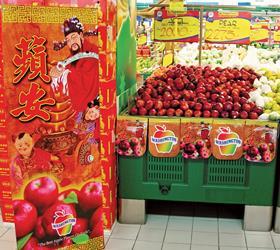
China’s apple imports are expected to increase 50 per cent to 100,000 tonnes in 2015/16 compared to the previous season, according to the latest USDA Gain report.
While Chile remains the leading supplier of apples to China, the increase in imports is expected to come off the back of China giving market access to all US apple varieties earlier this year.
With educational programmes in the works to boost consumers awareness of newer varieties such as Honey Crisp, the USDA report has forecast that US apples will regain their import market share that had been lost to other suppliers, such as Australia and New Zealand.
Pear imports are expected to be up 20 per cent to 12,000 tonnes due to the increase in consumer awarensess of Western-style pears, with the US remaining the largest supplier.
Grape imports, meanwhile, are forecast to grow 10 per cent to 250,000 tonnes with Chile remaining the top supplier. Peru has overtaken the US as the second largest supplier, with further growth expected as Peru’s import tariffs drop to zero under its free trade agreement with China.
Overall, China’s consumption of fruit is expected to continue its upward trend aided by dietary changes, though the slowing GDP growth has been cited for limiting the growth of fruit consumption in some demographics.
“As a result of the economic slowdown, fruit prices have all decreased from the previous year,” the USDA report stated. “On the other hand, consumption of imported fruit continues to increase at a fairly quick pace in large cities aided by the development of e-commerce which targets mainly the consumers with higher disposable income and young professionals.”
Domestic production on the rise
China’s apple production has steadily increased over the past ten years, though production growth is forecast to slow as new acreage for apple orchards becomes limited. China is forecast to increase its apple production by 5 per cent to 43m tonnes in 2015/16 compared to the previous year, with Fuji apples accounting for almost 70 per cent of China’s total apple production.
Growers are replacing orchards with new plantings and investing in higher density plantings that allow for easier use of machines, to reduce production cost, with 30 per cent of China’s major apple producing region Shaanxi expected to use high density farming by 2020.
Favourable growing conditions will increase pear production by 6 per cent to 19m tonnes in 2015/16 compared to the previous season, with acreage remaining stable at 1.1m ha.
Grape production is expected to increase 9 per cent to 9.6m tonnes due to increased plantations.



